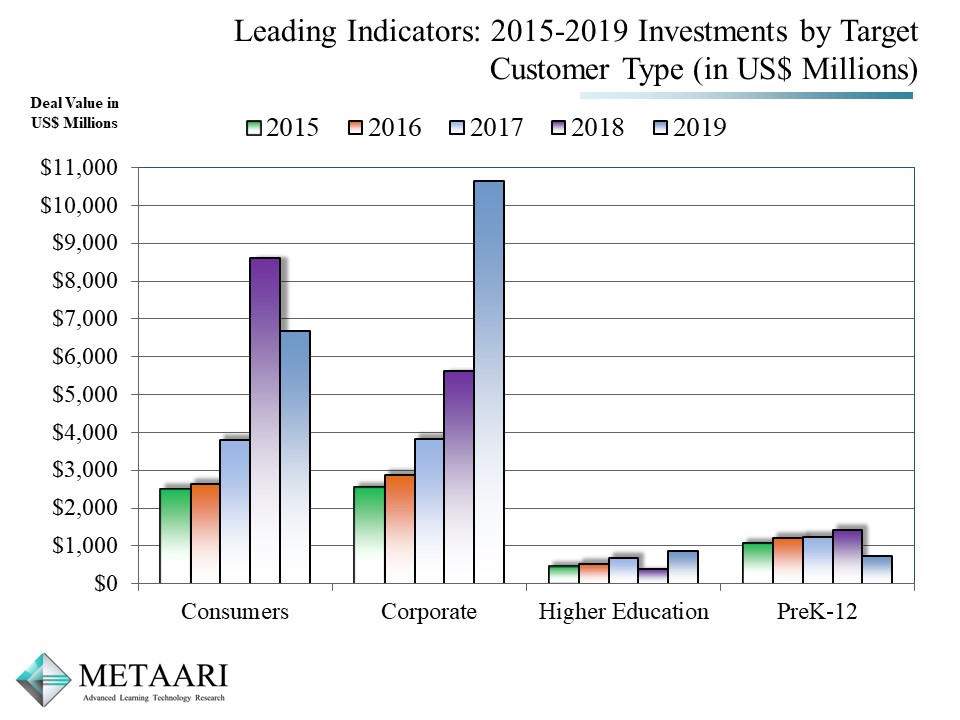PreK-12 Ed-Tech Investments Plunged in 2019, Bucking Overall Learning Tech Trend
Funding for ed-tech companies serving preK-12 around the world declined by nearly 50 percent last year compared to 2018, according to a report released earlier this month by Metaari, a quantitative research firm.
That’s despite the fact that 2019 set a new record for all learning technology segments—consumers, corporate, higher education and preK-12—with $18.66 billion invested globally, according to the company’s research report.
In preK-12, investment in 84 deals amounted to a total of $855.32 million last year, compared to 144 deals worth $1.42 billion in 2018.
Analyst Sam Adkins, CEO and chief researcher at Metaari, wrote that this decline in preK-12 investments represents a surprising pattern. EdWeek Market Brief asked him why the dramatic change occurred, and he came up with a number of possible theories, while cautioning that it’s impossible to know for sure.
“I track investment and the one consistent thing I have seen over the decades is that you can’t draw conclusions or make predictions based on any given year,” said Adkins in an emailed response to questions about why there was such a dip in the academic market globally.

Looking across segments, investor enthusiasm elsewhere might be one reason. “It may not be an aversion to preK-12 but rather a ‘grass is greener’ story,” Adkins said in the email. The corporate segment appears to be attracting investor interest because of “the revenues being generated by startups selling next-generation products” there, Adkins said.
Another possibility is that it is a “product substitution side effect as investors migrate away from legacy products,” Adkins said. In preK-12 and higher education, “things change very slowly…and tech adoption is still traditional rather than disruptive.” Schools and universities might keep their ed-tech products longer, rather than introducing new ones.
Softness in global markets is another potential contributor. Among the many factors inhibiting preK-12 growth across the globe is “the general weakness of Latin American economies and the draconian regulations in China,” said Adkins. “It is very hard for ed-tech [companies] to gain traction in China right now. Even the domestic giants are investing outside of the country.”
The full report, “The 2019 Global Learning Technologies Investment Patterns: Another Record-Shattering Year,” is available here.
Follow EdWeek Market Brief on Twitter @EdMarketBrief or connect with us on LinkedIn.
See also:

Hmmm, perhaps you could ask a few regular classroom teachers about how effective (not) or reliable (not) the programs and hardware are. And I don’t mean the “techie” teachers who may or may not stay in teaching. Ask teachers who’ve been in the classroom for 5-10 years. Ask how tech has improved their teaching–especially elementary teachers. Ask, rather, how much time all this data collection and entry is taking them. Ask how much professional development is now about how to use all this tech instead of creating great lessons. And now teachers are expected to “grade” elementary students on cooperation and creativity, etc. Soon, apparently, we’ll all be asked to “grade” your child’s “social-emotional” development–whatever that means–and I wonder what entity is going to be responsible for maintaining the privacy of your child’s social-emotional records. Oh, wait, that will be all next year’s professional development. Silly me. When will business leaders and politicians ever ask an actual in the trenches teacher. I’m waiting for the call.
It does sound rather like people in the schools are getting smart and realizing children don’t need all this.
Considering that the more tech in the class room the worse kids academic performance it sounds like maybe they’re learning something! Better to give the money to the teachers who are making a real difference. “U.S.-specific studies reach similar conclusions. Austan Goolsbee, before he was chair of President Obama’s Council of Economic Advisers, found that four years of investments in education technology in California public schools had no statistically significant impact on student performance. In another study, a randomized, controlled trial giving computers to U.S. students in grades six to ten had no measurable impact on homework time, grades, standardized test scores, or attendance, and some trials saw negative effects. In a study of over seven hundred students at West Point, those with computers in class had test scores 0.2 standard deviations below those of students who did not.” 10 Austan Goolsbee and Jonathan Guryan, “The Impact of Internet Subsidies in Public Schools,” Review of Economics and Statistics 88, no. 2 (May 2006). 11 Maya Escueta, Vincent Quan, Andre Joshua Nickow, and Philip Oreopoulos, “Education Technology: An Evidence-Based Review,” NBER Working Paper no. 23744, August 2017. 12 Susan Carter, Kyle Greenberg, and Michael Walker, “The Impact of Computer Usage on Academic Performance: Evidence from a Randomized Trial at the United States Military Academy,” SEII Discussion Paper no. 2016.02, May 2016.